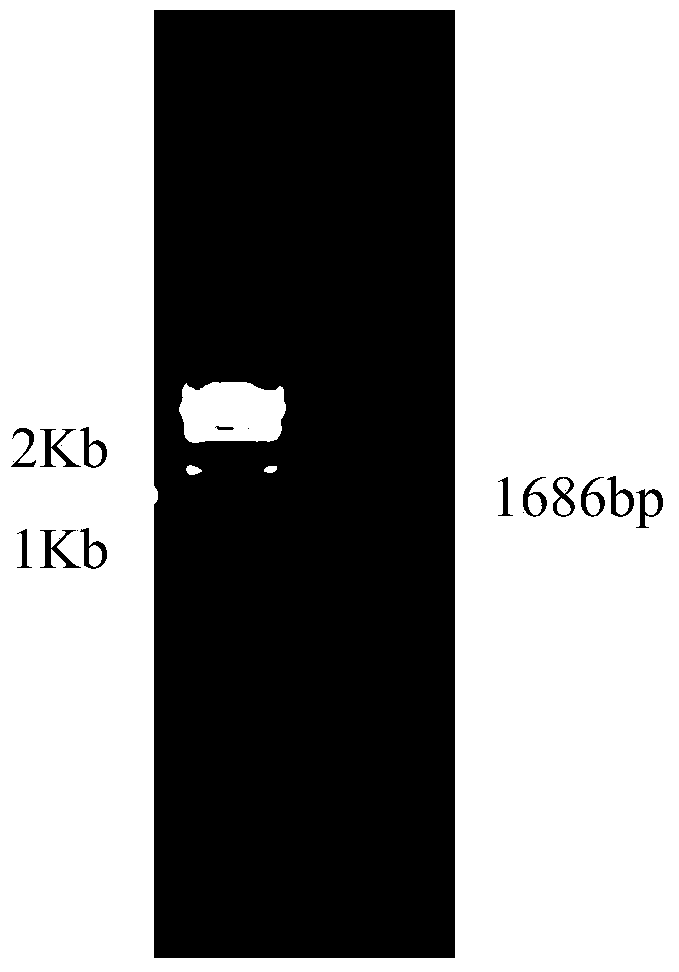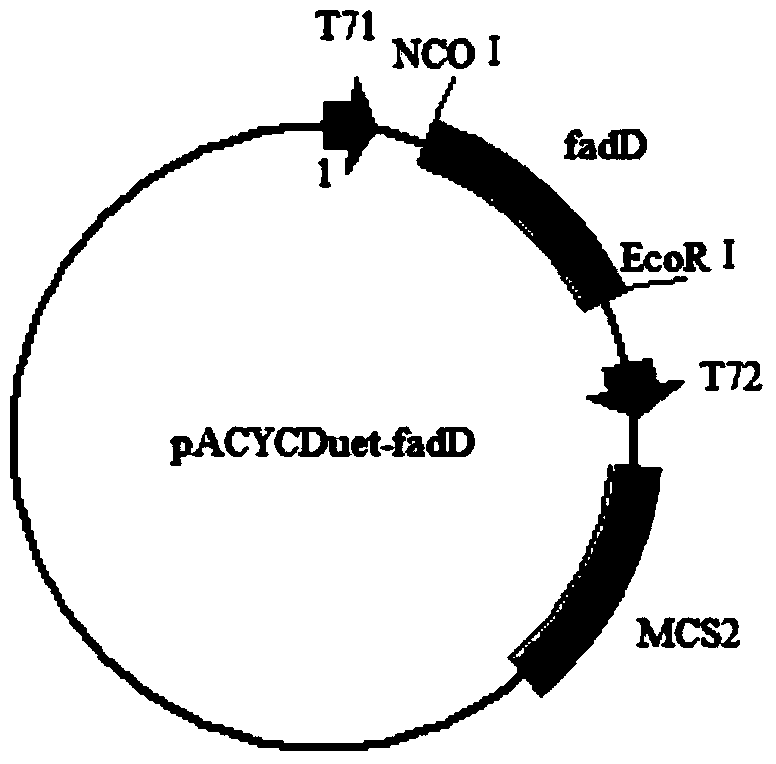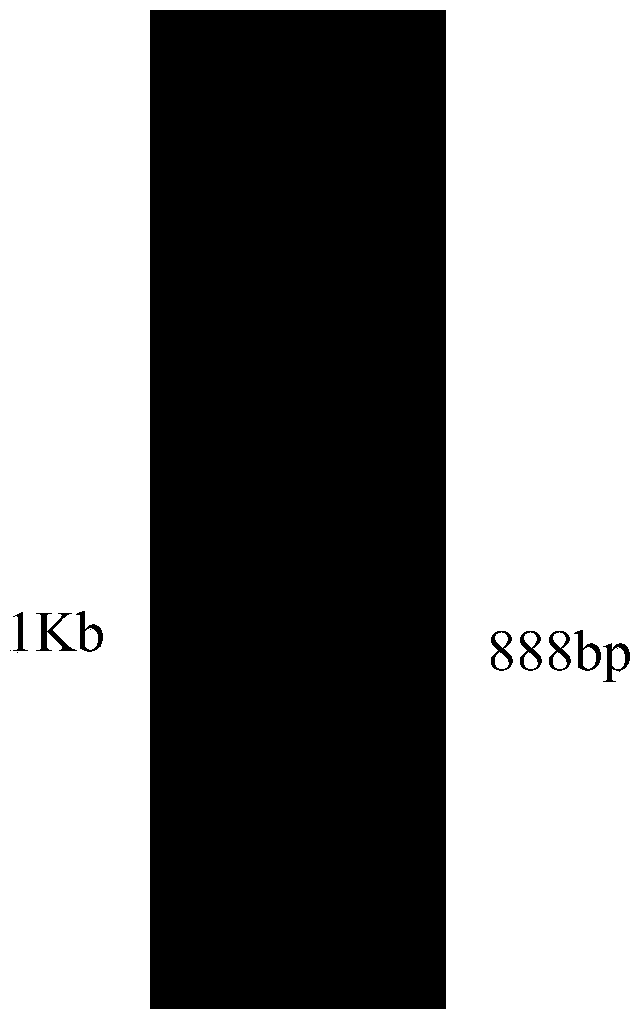Method for producing medium-chain alkanes
A production method and paraffin technology, which is applied in the field of production of medium-carbon paraffins, and can solve the problem of producing very few paraffins
- Summary
- Abstract
- Description
- Claims
- Application Information
AI Technical Summary
Problems solved by technology
Method used
Image
Examples
Embodiment 1
[0038] 1 Cloning of acyl-CoA synthetase in Escherichia coli and construction of recombinant vector
[0039] 1.1 Cloning of acyl-CoA synthetase in Escherichia coli
[0040] The genome of Escherichia coli (Escherichia coli) K12 strain was extracted using the Bomide kit method, and the genome DNA of Escherichia coli was used as a template to design primers according to the GenBank sequence, and the corresponding enzyme cutting sites (NCOI and EcoRI) and protective bases were added, The acyl-CoA synthetase [acyl-CoA synthetase] gene encoded by fadD was amplified by PCR, and the acyl-CoA synthetase induced by the gene can metabolize fatty acids to generate ester acyl-CoA.
[0041] The primers used for PCR amplification of the acyl-CoA synthetase gene fadD are as follows:
[0042] Upstream primer: 5'-CATG CCATGG GCAAGAAGGTTTGGCTTAACC-3'
[0043] Downstream primer: 5'-CG GAATTC CGGCTCAGGCTTTATTGTCCACT-3'
[0044] The PCR reaction system contained 0.2 μL of genomic DNA, 0.25 μL...
Embodiment 2
[0051] 1 Cloning of acyl-CoA reductase in Acinetobacter and construction of recombinant vector
[0052] 1.1 Cloning of acyl-CoA reductase in Acinetobacter
[0053] The DNA of the acyl-CoA reductase [acyl-CoA reductase] gene in Acinetobacter baylyi was synthesized by the method of total gene synthesis. The gene-induced expression of acyl-CoA reductase can catalyze the reduction reaction of ester acyl-CoA accumulated in cells to generate C14 / C16 fatty aldehydes.
[0054] Using the acyl-CoA reductase gene DNA synthesized above as a template, primers were designed according to the GenBank sequence, and corresponding restriction sites (NCOⅠ and BamHI) and protective bases were added.
[0055] The primers used for PCR amplification of acyl-CoA reductase gene acr are as follows:
[0056] Upstream primer: 5'-GCAGCCCATGGCTAGCATGAACGCTAAAC-3'
[0057] Downstream primer: 5'-CCGCTGGATCCTTACCAGTGTTCACCTGG-3'
[0058] The PCR reaction system contained 0.2 μL of genomic DNA, 0.25 μL of u...
Embodiment 3
[0065] 1 Cloning of aldehyde decarbonylase from Nostoc algae and construction of recombinant vector
[0066] 1.1 Cloning of aldehyde decarbonylase from Nostoc algae
[0067] The aldehyde decarbonylase [aldehyde decarboxylase] gene DNA in Nostoc punctiforme was synthesized by the method of total gene synthesis. The aldehyde decarbonylase induced by this gene can catalyze the decarbonylation of aliphatic aldehydes to generate alkanes.
[0068] The gene is handed over to the company for synthesis, and after synthesis, it becomes the pUCE-dc plasmid and the strain containing the plasmid. Inoculate the glycerol tube of the strain into LB liquid medium for cultivation, and extract the plasmid with an omega kit, so that the plasmid containing the aldehyde decarbonylase gene dc can be cloned:
[0069] This gene sequence length is 699bp, utilizes 1% agarose gel electrophoresis to detect, and the obtained target DNA band is 699bp (such as Figure 5 shown).
[0070] 1.2 Construction ...
PUM
 Login to View More
Login to View More Abstract
Description
Claims
Application Information
 Login to View More
Login to View More - R&D
- Intellectual Property
- Life Sciences
- Materials
- Tech Scout
- Unparalleled Data Quality
- Higher Quality Content
- 60% Fewer Hallucinations
Browse by: Latest US Patents, China's latest patents, Technical Efficacy Thesaurus, Application Domain, Technology Topic, Popular Technical Reports.
© 2025 PatSnap. All rights reserved.Legal|Privacy policy|Modern Slavery Act Transparency Statement|Sitemap|About US| Contact US: help@patsnap.com



